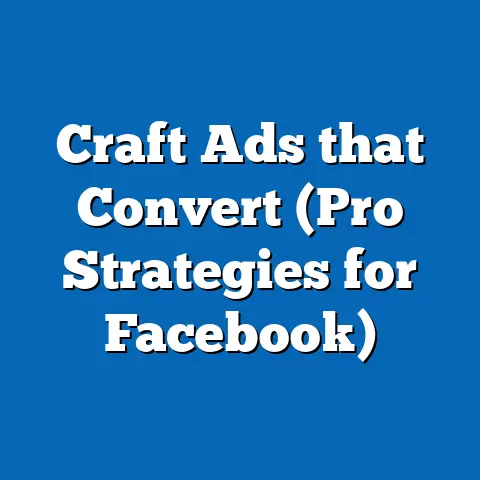Master Cookie Creation for Targeted Facebook Ads (Expert Guide)
In the world of digital marketing, cookies aren’t just for dessert; they’re the secret sauce that can make or break your Facebook ad campaigns. I’ve seen firsthand how a well-crafted cookie strategy can transform a struggling campaign into a roaring success. Conversely, neglecting this crucial aspect can lead to wasted ad spend and disappointing results. This guide is designed to equip you with the knowledge and tools to master cookie creation, enabling you to create highly targeted and effective Facebook ads. Let’s dive in!
Understanding Cookies in Digital Marketing
Let’s break down what cookies are and why they’re so important. Simply put, cookies are small text files that websites store on a user’s computer or mobile device. These files contain information about the user’s browsing activity, such as the pages they’ve visited, the products they’ve viewed, and the actions they’ve taken on the website.
There are several types of cookies, each with its own purpose:
- Session Cookies: These are temporary cookies that are stored in the browser’s memory and are deleted when the browser is closed. They’re often used to remember items in a shopping cart or to keep a user logged in during a single browsing session.
- Persistent Cookies: These cookies remain on the user’s device for a specified period, even after the browser is closed. They’re used to remember user preferences, such as language settings or login information, for future visits.
- First-Party Cookies: These cookies are set by the website that the user is currently visiting. They’re generally used to improve the user experience on that specific website.
- Third-Party Cookies: These cookies are set by a domain different from the website the user is visiting. They’re often used for cross-site tracking and targeted advertising. Think of them as little digital spies, following you across the web.
The magic of cookies lies in their ability to track user behavior and preferences. This data allows advertisers to create highly targeted ads that are relevant and engaging to specific audiences. For example, if a user visits a website selling running shoes and views several pairs of shoes, cookies can be used to show them ads for those same shoes on Facebook. This increases the likelihood that they’ll click on the ad and make a purchase.
However, it’s crucial to be aware of data privacy regulations like GDPR (General Data Protection Regulation) and CCPA (California Consumer Privacy Act). These regulations place strict limits on how personal data can be collected and used, including data collected through cookies. I’ve had to completely revamp cookie strategies for clients to ensure compliance, which involved implementing consent mechanisms and providing clear information about data usage.
Key Takeaway: Cookies are essential for tracking user behavior and enabling targeted advertising, but it’s crucial to understand the different types of cookies and to comply with data privacy regulations.
The Importance of Targeted Advertising on Facebook
Why is targeted advertising so crucial, especially on a platform like Facebook? The answer is simple: it’s more effective and efficient than traditional advertising methods. Instead of broadcasting your message to a broad audience, you can focus your efforts on reaching the people who are most likely to be interested in your products or services.
Think about it: would you rather show your ad for vegan protein powder to everyone on Facebook, or just to people who have expressed an interest in veganism, fitness, or healthy eating? The latter is far more likely to result in clicks, conversions, and ultimately, sales.
Facebook’s advertising reach is staggering. According to recent statistics, Facebook has billions of active users, making it one of the largest and most powerful advertising platforms in the world. This massive reach, combined with Facebook’s sophisticated targeting capabilities, allows businesses to connect with their ideal customer segments with incredible precision.
I remember working with a local bakery that was struggling to attract new customers. By using Facebook’s targeting options, we were able to show their ads to people who lived within a certain radius of the bakery, who had expressed an interest in baking or desserts, and who were of a certain age and income level. The result was a significant increase in foot traffic and sales.
This brings us to the concept of audience segmentation. Cookies play a vital role in this process by allowing you to divide your audience into smaller, more specific groups based on their behavior and preferences. For example, you can create a segment of users who have visited your website but haven’t made a purchase, and then show them ads with special offers or discounts to encourage them to convert.
Key Takeaway: Targeted advertising is more effective and efficient than traditional advertising, and Facebook’s massive reach and sophisticated targeting capabilities make it an ideal platform for reaching your ideal customer segments. Cookies are essential for audience segmentation, allowing you to create highly targeted ads that resonate with specific groups of users.
Creating Effective Cookies for Facebook Ads
Now, let’s get down to the nitty-gritty: how do you actually create and implement cookies for your Facebook ad campaigns? Here’s a step-by-step guide:
-
Setting Up Your Facebook Pixel: The Facebook Pixel is a snippet of code that you place on your website. It allows Facebook to track user behavior on your site, such as page views, add-to-carts, and purchases. To set up your Pixel, go to the Events Manager in your Facebook Ads Manager account and follow the instructions. This is the foundation of your cookie strategy.
-
Customizing Cookie Settings: Once your Pixel is installed, you can customize your cookie settings to track specific events and user behaviors. For example, you can track when users view a particular product page, add an item to their cart, or complete a purchase. This data can then be used to create custom audiences for your Facebook ads.
-
Ensuring Compliance with Privacy Regulations: It’s crucial to obtain user consent before setting cookies on their devices. This can be done by displaying a cookie consent banner on your website that informs users about the cookies you’re using and asks for their permission. You should also provide a clear and easy-to-understand privacy policy that explains how you collect, use, and protect user data. I always recommend consulting with a legal professional to ensure that your cookie practices are fully compliant with all applicable regulations.
-
A/B Testing Cookie Strategies: Don’t just set it and forget it! A/B testing is essential for optimizing your cookie strategies. Try different cookie settings, ad creatives, and targeting options to see what works best for your audience. For example, you can test different cookie durations to see how long you should track users before showing them ads.
Setting Up Your Facebook Pixel: The Facebook Pixel is a snippet of code that you place on your website. It allows Facebook to track user behavior on your site, such as page views, add-to-carts, and purchases. To set up your Pixel, go to the Events Manager in your Facebook Ads Manager account and follow the instructions. This is the foundation of your cookie strategy.
Customizing Cookie Settings: Once your Pixel is installed, you can customize your cookie settings to track specific events and user behaviors. For example, you can track when users view a particular product page, add an item to their cart, or complete a purchase. This data can then be used to create custom audiences for your Facebook ads.
Ensuring Compliance with Privacy Regulations: It’s crucial to obtain user consent before setting cookies on their devices. This can be done by displaying a cookie consent banner on your website that informs users about the cookies you’re using and asks for their permission. You should also provide a clear and easy-to-understand privacy policy that explains how you collect, use, and protect user data. I always recommend consulting with a legal professional to ensure that your cookie practices are fully compliant with all applicable regulations.
A/B Testing Cookie Strategies: Don’t just set it and forget it! A/B testing is essential for optimizing your cookie strategies. Try different cookie settings, ad creatives, and targeting options to see what works best for your audience. For example, you can test different cookie durations to see how long you should track users before showing them ads.
I once worked with an e-commerce client who was struggling to generate sales from their Facebook ads. After analyzing their cookie data, we discovered that they were only tracking users for a short period, which meant that they were missing out on potential customers who were still in the research phase. By extending the cookie duration, we were able to show ads to these users for a longer period, resulting in a significant increase in sales.
Key Takeaway: Creating effective cookies for Facebook ads involves setting up your Facebook Pixel, customizing your cookie settings, ensuring compliance with privacy regulations, and A/B testing your strategies.
Analyzing Cookie Data to Enhance Ad Performance
Collecting cookie data is only half the battle. The real magic happens when you analyze that data to gain insights into user behavior and preferences. This information can then be used to refine your advertising strategies and improve your ad performance.
Here are some key metrics to monitor:
- Click-Through Rate (CTR): This is the percentage of people who see your ad and click on it. A high CTR indicates that your ad is relevant and engaging to your target audience.
- Conversion Rate: This is the percentage of people who click on your ad and then complete a desired action, such as making a purchase or filling out a form. A high conversion rate indicates that your ad is effectively driving results.
- Cost Per Acquisition (CPA): This is the amount you spend to acquire a new customer. A low CPA indicates that your advertising is efficient and cost-effective.
- Return on Ad Spend (ROAS): This is the amount of revenue you generate for every dollar you spend on advertising. A high ROAS indicates that your advertising is profitable.
By monitoring these metrics and analyzing your cookie data, you can identify areas where you can improve your advertising strategies. For example, if you notice that your CTR is low, you may need to revise your ad creative or targeting options. If your conversion rate is low, you may need to improve your landing page or offer a more compelling offer.
I remember working with a travel company that was struggling to generate bookings from their Facebook ads. After analyzing their cookie data, we discovered that many users were clicking on their ads but then abandoning the booking process before completing their purchase. By implementing a retargeting campaign that showed these users ads with special discounts and incentives, we were able to significantly increase their booking rate.
Key Takeaway: Analyzing cookie data is essential for gaining insights into user behavior and preferences, which can then be used to refine your advertising strategies and improve your ad performance. Monitor key metrics such as CTR, conversion rate, CPA, and ROAS to identify areas for improvement.
Case Studies: Successful Facebook Ad Campaigns Utilizing Cookies
Let’s look at some real-world examples of how brands have effectively used cookies to enhance their Facebook advertising efforts:
Case Study 1: E-commerce Retailer (Fashion)
- Challenge: Low conversion rates on Facebook ads.
- Strategy: Implemented a retargeting campaign targeting users who had viewed specific products on their website but hadn’t made a purchase. The ads featured images of the products they had viewed, along with a special discount code.
- Results: Conversion rates increased by 150%, and ROAS increased by 200%.
- Key Lesson: Retargeting users who have shown interest in specific products can be highly effective for driving sales.
Case Study 2: Online Education Platform
- Challenge: Difficulty attracting new students to their online courses.
- Strategy: Created custom audiences based on user behavior on their website, such as users who had visited specific course pages or downloaded free resources. They then showed these users ads that highlighted the benefits of their courses and offered a free trial.
- Results: Enrollment rates increased by 80%, and CPA decreased by 50%.
- Key Lesson: Creating custom audiences based on user behavior can be highly effective for attracting new customers.
Case Study 3: Local Restaurant
- Challenge: Struggling to attract new customers to their restaurant.
- Strategy: Implemented a Facebook Pixel on their website and tracked users who had viewed their menu or made a reservation. They then showed these users ads that featured photos of their food and offered a special discount for first-time customers.
- Results: Foot traffic increased by 40%, and revenue increased by 30%.
- Key Lesson: Even local businesses can benefit from using cookies to target their advertising efforts.
Key Takeaway: These case studies demonstrate the power of cookies to enhance Facebook advertising efforts. By implementing retargeting campaigns, creating custom audiences, and tracking user behavior, brands can significantly improve their ad performance and drive results.
Future Trends in Cookie Usage and Facebook Advertising
The world of digital advertising is constantly evolving, and cookie usage is no exception. As privacy concerns continue to grow, there’s a shift towards first-party cookies and a greater emphasis on data privacy.
Here are some emerging trends to watch out for:
- The Decline of Third-Party Cookies: Many web browsers are phasing out support for third-party cookies, which means that advertisers will need to rely more on first-party data and other targeting methods.
- The Rise of First-Party Data: First-party data is data that you collect directly from your customers, such as their email addresses, purchase history, and website behavior. This data is becoming increasingly valuable as third-party cookies become less reliable.
- The Importance of Data Privacy: Consumers are becoming more aware of data privacy issues and are demanding more control over their personal data. Advertisers need to be transparent about how they collect and use data, and they need to provide users with the ability to opt out of tracking.
- The Potential of New Technologies: New technologies, such as artificial intelligence and machine learning, are being used to develop more sophisticated targeting methods that don’t rely on cookies.
As the landscape of digital advertising continues to evolve, it’s crucial to stay informed and adaptable. I believe that the future of targeted advertising will be more focused on first-party data, data privacy, and innovative technologies.
Key Takeaway: The future of cookie usage and Facebook advertising is evolving, with a shift towards first-party data, data privacy, and innovative technologies. Stay informed and adaptable to stay ahead of the curve.
Conclusion
Mastering cookie creation is essential for creating effective Facebook ad campaigns. By understanding the different types of cookies, implementing a robust cookie strategy, analyzing cookie data, and staying informed about future trends, you can significantly improve your ad performance and drive results.
I encourage you to implement the strategies outlined in this guide to enhance your own advertising efforts. Start by setting up your Facebook Pixel, customizing your cookie settings, and ensuring compliance with privacy regulations. Then, begin analyzing your cookie data to gain insights into user behavior and preferences. Finally, stay informed about future trends and adapt your strategies accordingly.
With the right knowledge and tools, you can harness the power of cookies to create highly targeted and effective Facebook ads that reach your ideal customers and drive business growth. Now, go forth and bake some amazing cookie-powered ad campaigns!






